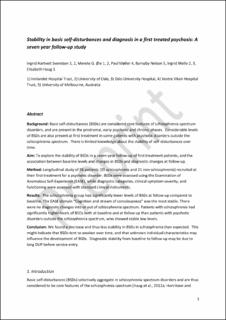| dc.contributor.author | Svendsen, Ingrid Hartveit | |
| dc.contributor.author | Øie, Merete Glenne | |
| dc.contributor.author | Møller, Paul | |
| dc.contributor.author | Nelson, Barnaby | |
| dc.contributor.author | Melle, Ingrid | |
| dc.contributor.author | Haug, Elisabeth | |
| dc.coverage.spatial | Norge | en_US |
| dc.date.accessioned | 2022-04-07T13:47:41Z | |
| dc.date.available | 2022-04-07T13:47:41Z | |
| dc.date.created | 2018-07-10T14:56:55Z | |
| dc.date.issued | 2018 | |
| dc.identifier.issn | 0920-9964 | |
| dc.identifier.uri | https://hdl.handle.net/11250/2990585 | |
| dc.description.abstract | Background: Basic self-disturbances (BSDs) are considered core features of schizophrenia spectrum disorders, and are present in the prodromal, early psychotic and chronic phases. Considerable levels of BSDs are also present at first treatment in some patients with psychotic disorders outside the schizophrenia spectrum. There is limited knowledge about the stability of self-disturbances over time.
Aim: To explore the stability of BSDs in a seven-year follow-up of first treatment patients, and the association between baseline levels and changes in BSDs and diagnostic changes at follow-up.
Method: Longitudinal study of 56 patients (35 schizophrenia and 21 non-schizophrenia) recruited at their first treatment for a psychotic disorder. BSDs were assessed using the Examination of Anomalous Self-Experience (EASE), while diagnostic categories, clinical symptom severity, and functioning were assessed with standard clinical instruments.
Results: The schizophrenia group had significantly lower levels of BSDs at follow-up compared to baseline. The EASE domain "Cognition and stream of consciousness" was the most stable. There were no diagnostic changes into or out of schizophrenia spectrum. Patients with schizophrenia had significantly higher levels of BSDs both at baseline and at follow up than patients with psychotic disorders outside the schizophrenia spectrum, who showed stable low levels.
Conclusion: We found a decrease and thus less stability in BSDs in schizophrenia than expected. This might indicate that BSDs tent to weaken over time, and that unknown individual characteristics may influence the development of BSDs. Diagnostic stability from baseline to follow-up may be due to long DUP before service entry. | en_US |
| dc.language.iso | eng | en_US |
| dc.publisher | Elsevier | en_US |
| dc.rights | Attribution-NonCommercial-NoDerivatives 4.0 Internasjonal | * |
| dc.rights.uri | http://creativecommons.org/licenses/by-nc-nd/4.0/deed.no | * |
| dc.subject | Bipolar disorder; | en_US |
| dc.subject | Early intervention; | en_US |
| dc.subject | Examination of anomalous self-experience; | en_US |
| dc.subject | Phenomenology; | en_US |
| dc.subject | Schizophrenia. | en_US |
| dc.title | Stability in basic self-disturbances and diagnosis in a first treated psychosis: A seven year follow-up study | en_US |
| dc.type | Peer reviewed | en_US |
| dc.type | Journal article | en_US |
| dc.description.version | acceptedVersion | en_US |
| dc.source.pagenumber | 274-280 | en_US |
| dc.source.volume | 202 | en_US |
| dc.source.journal | Schizophrenia Research | en_US |
| dc.identifier.doi | 10.1016/j.schres.2018.07.011 | |
| dc.identifier.cristin | 1596587 | |
| cristin.unitcode | 1991,9,0,0 | |
| cristin.unitcode | 1991,1,2,0 | |
| cristin.unitname | Div Psykisk helsevern | |
| cristin.unitname | Avd Forskning | |
| cristin.ispublished | false | |
| cristin.fulltext | preprint | |
| cristin.fulltext | postprint | |
| cristin.qualitycode | 2 | |

